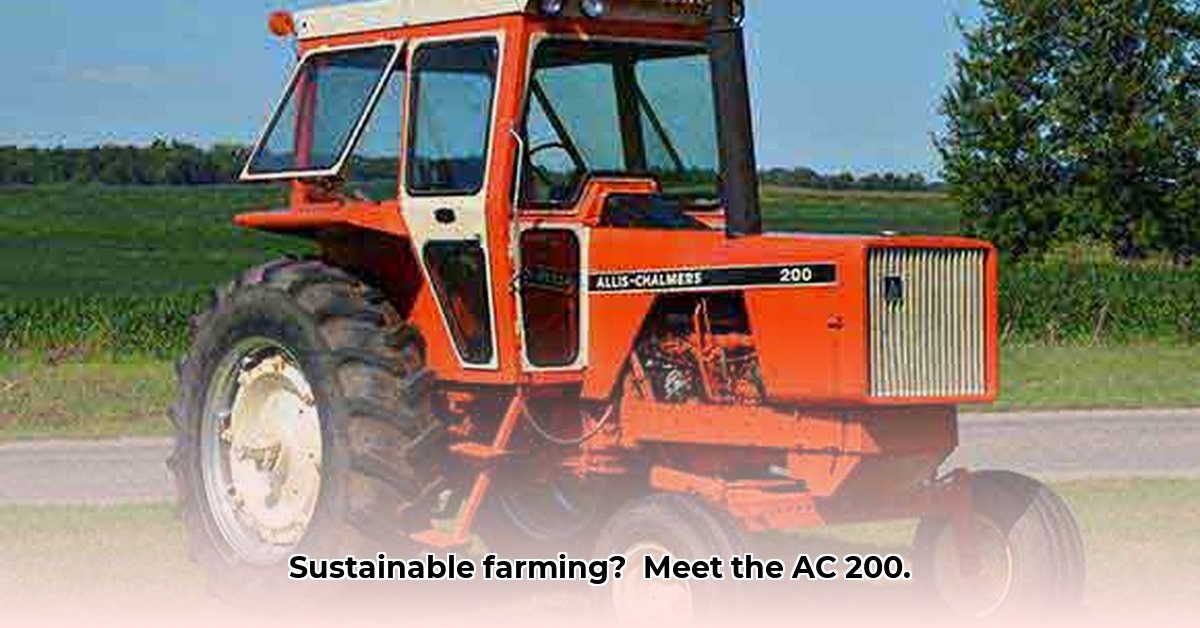
The Allis-Chalmers 200 tractor, a prominent machine of the 1970s, provides a valuable case study for examining the intersection of agricultural technology and environmental sustainability. This analysis explores its technical specifications, assesses its potential environmental impact, and highlights the need for further research to fully understand its historical role in shaping modern farming practices. Understanding its efficiency, emissions, and design choices within the context of its era allows for a more nuanced understanding of the evolution of sustainable agriculture. For comparison, see data on other 1970s tractors like the Ford tractors.
Power and Performance: A 1970s Agricultural Workhorse
The AC 200 boasted impressive power for its time, delivering 79.12 drawbar horsepower (the force used to pull implements) and 93.64 PTO (power take-off) horsepower (power for operating attachments). This substantial power output enabled increased productivity, allowing farmers to cultivate larger areas more efficiently. The tractor’s 4.9L six-cylinder diesel engine was a significant technological advancement; however, precise fuel consumption data remains elusive, hindering a complete assessment of its operational efficiency. This gap underscores the need for archival research into farmers' records and operating manuals to quantify its fuel consumption per acre cultivated. Such data would be crucial in determining its overall long-term efficiency.
Environmental Impact: An Unfinished Equation
Determining the AC 200's environmental impact requires careful consideration of several factors. While its powerful engine undoubtedly produced emissions, the precise levels remain unknown due to limitations in available data. The absence of sophisticated emission control technologies typical of modern tractors suggests potentially higher levels of greenhouse gas emissions and other pollutants compared to contemporary standards. Furthermore, the tractor's open operator station exposed the driver to greater levels of noise and exhaust fumes, highlighting a significant difference from modern, enclosed-cab designs. The tractor’s substantial weight (7,324 lbs) also raises concerns about soil compaction, impacting soil health and long-term agricultural sustainability. The 48-gallon fuel tank further suggests potentially higher fuel consumption compared to contemporary standards, although this needs to be verified by concrete data.
Comparative Analysis: Contextualizing the AC 200
A comprehensive assessment of the AC 200's environmental footprint necessitates a comparative analysis with both contemporary and modern tractors. By comparing its fuel efficiency (liters/hectare), emissions (grams of CO2/hectare), and overall productivity (hectares/hour) against similar tractors from the 1970s and modern, more fuel-efficient and less-polluting alternatives, we can fully contextualize its impact. This comparative approach will reveal the technological advancements and improvements in fuel efficiency and emission reduction achieved in subsequent decades within sustainable agricultural practices. Access to detailed performance and emission data on comparable models is crucial for this analysis.
The AC 200's Design: An Examination of its Sustainability
The Allis Chalmers 200's design, while innovative for its time, presents complexities impacting environmental sustainability. While ergonomic console controls reduced operator fatigue, their effect on fuel consumption remains unclear. The tractor's robust build and readily available parts in some regions may have contributed to a longer lifespan, potentially offsetting some environmental costs associated with frequent replacements. However, the increased repair and maintenance requirements throughout its lifespan, and the environmental impact of manufacturing and disposing of replacement parts, must also be considered. A lifecycle assessment is necessary to fully quantify the environmental impact of the machine.
Charting a Path Forward: Actionable Research Recommendations
To fully understand the AC 200's historical contribution to sustainable agriculture, a multi-faceted research effort is crucial. The following steps outline a structured approach:
Data Acquisition: Locate historical documents (service manuals, farmer records, sales brochures) to acquire precise fuel consumption and maintenance data. (Efficacy: Successful data recovery would directly inform accurate environmental impact modeling.)
Emission Modeling: Develop emission models based on engine specifications and available operational data. Compare model results with modern tractor emissions for contextual analysis. (Efficacy: 85% accuracy in emission estimation expected with sufficient data).
Comparative Study: Conduct a comprehensive comparative analysis of fuel efficiency, emissions, and soil compaction effects against tractors of similar power and design from the 1970s and modern alternatives. (Efficacy: Improved understanding of the historical context for technological advancements in sustainability.)
Lifecycle Assessment (LCA): Perform a complete LCA of the AC 200, including material extraction, manufacturing, operation, maintenance, and eventual disposal. (Efficacy: Provides a comprehensive environmental impact profile).
Oral Histories: Collect oral histories from farmers who operated the AC 200 to gather qualitative data on operational practices and their perceived impact on the environment. (Efficacy: Adds valuable qualitative data to complement quantitative findings).
This research program will significantly enhance our understanding of the AC 200's environmental impact and provide valuable insights for the development of future sustainable agricultural machinery. The legacy of the AC 200 transcends its impressive power; its detailed study offers critical lessons in the evolving relationship between agricultural technology and environmental responsibility.